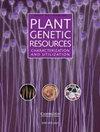选择配合力较好的自交系,有助于培育以cms为基础的热带胡萝卜杂种。
IF 0.7
4区 生物学
Q3 PLANT SCIENCES
Plant Genetic Resources: Characterization and Utilization
Pub Date : 2023-09-08
DOI:10.1017/s1479262123000692
引用次数: 0
摘要
胡萝卜是世界范围内重要的蔬菜作物,因其肉质可食用的各种颜色的根而受到重视。细胞质雄性不育由于其高度异花授粉的特性和小花的大小,被用于杂交发育。在不同类型的雄性不育中,花瓣型CMS在全球范围内被广泛应用于胡萝卜杂交育种。本研究旨在建立利用CMS株系培育杂种F1的亲本选择标准。利用大量的农业形态性状和简单重复序列(ssrs)来评估亲本间的多样性。通过4个花瓣型CMS系和15个亲本杂交设计,获得60个F1杂交品种,并通过重复随机区组设计试验对4个营养性状和11个经济性状进行评价。各性状的均方差均显著。遗传成分方差估计表明,除根成熟度、根长和根芯直径外,非加性基因作用占主导地位。自身性能最高的杂交种也有显著的正比配合力效应。根产量和根重的杂种优势率最高(33%)。杂种优势表现最好的是DCatH-5392、DCatH-700和DCatH-9892。遗传距离与经济性状相对杂种优势的相关性不显著,不能作为预测杂种优势的依据。由于热带胡萝卜产量相关性状大部分受非加性基因作用控制,杂种优势选育与配合力分析相结合,可以减少热带胡萝卜最佳亲本和最佳杂交的选育时间。本文章由计算机程序翻译,如有差异,请以英文原文为准。
Selection of inbreds with better combining ability is instrumental in developing CMS-based heterotic hybrids in tropical carrot (Daucus carota L.)
Carrot is an important vegetable crop worldwide valued for its fleshy edible roots of varied colours. Owing to its highly cross-pollinated nature and small flower size, cytoplasmic male sterility (CMS) is being utilized for hybrid development. Among different types of male sterility, petaloid CMS is widely used for hybrid carrot breeding globally. This study aimed to develop selection criteria for parents in developing heterotic F1 hybrids using CMS lines. A large number of agro-morphological traits and Simple Sequence Repeats (genomic-SSRs) were used to assess the diversity among parental lines. We developed 60 F1 hybrids by crossing four petaloid CMS lines and 15 testers in line × tester mating design and evaluated them in replicated randomized block design trial for four vegetative and 11 economic traits. The mean squares of all the traits in line × tester interactions were significant. The estimates of genetic components of variance indicated predominance of non-additive gene action except for root maturity, root length and core diameter. The hybrids with highest per se performance also had significant positive specific combining ability effects. The root yield and root weight showed highest heterosis percentage (33%). The best performing heterotic hybrids were DCatH-5392, DCatH-700 and DCatH-9892. Correlation between genetic distance and relative heterosis of economic traits indicated no significant association and thus genetic distance could not be used to predict heterosis. As most of the yield-related traits were controlled by non-additive gene action, heterosis breeding could be potentially used along with combining ability analysis to reduce time in selection of best parents and crosses in tropical carrot.
求助全文
通过发布文献求助,成功后即可免费获取论文全文。
去求助
来源期刊

Plant Genetic Resources: Characterization and Utilization
Agricultural and Biological Sciences-Agronomy and Crop Science
CiteScore
2.80
自引率
0.00%
发文量
29
审稿时长
>12 weeks
期刊介绍:
Plant Genetic Resources is an international journal which provides a forum for describing the application of novel genomic technologies, as well as their integration with established techniques, towards the understanding of the genetic variation captured in both in situ and ex situ collections of crop and non-crop plants; and for the airing of wider issues relevant to plant germplasm conservation and utilisation. We particularly welcome multi-disciplinary approaches that incorporate both a technical and a socio-economic focus. Technical aspects can cover developments in technologies of potential or demonstrated relevance to the analysis of variation and diversity at the phenotypic and genotypic levels.
 求助内容:
求助内容: 应助结果提醒方式:
应助结果提醒方式:


